Arizona Vegetable & Fruit Gardening
For The Arizona Desert Environment.
Pictures, Photos, Images
Descriptions
Information, & Reviews.
Fragaria x ananassa "EarliGlow"
 |
| Strawberry or Strawberries, Fragaria x ananassa "EarliGlow". - Photo Taken June 25, 2011 In Yarnell, Arizona. In A Raised Bed Garden. Yarnell Community Garden Project. |
|---|
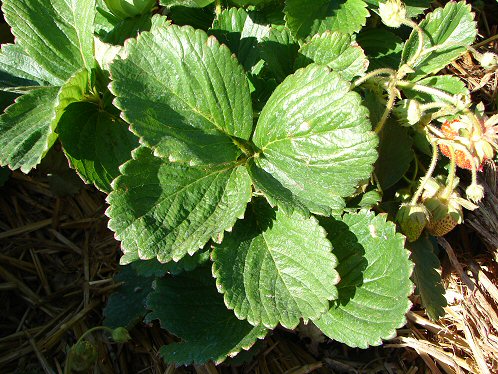 | 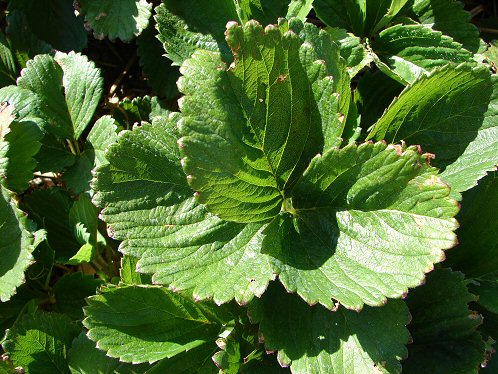 |
| Leaves. Strawberry or Strawberries, Fragaria x ananassa "EarliGlow." | Leaves. Strawberry or Strawberries, Fragaria x ananassa "EarliGlow." |
|---|---|
 | 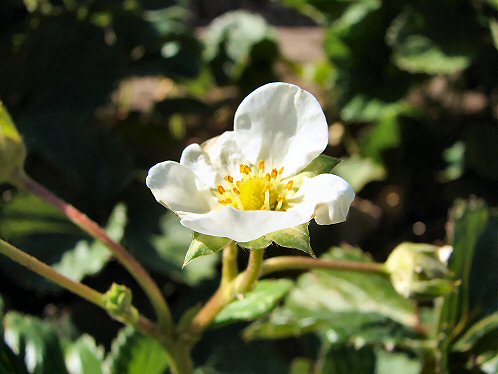 |
| Flowers. Strawberry or Strawberries, Fragaria x ananassa "EarliGlow." | Flowers. Strawberry or Strawberries, Fragaria x ananassa "EarliGlow." |
 | 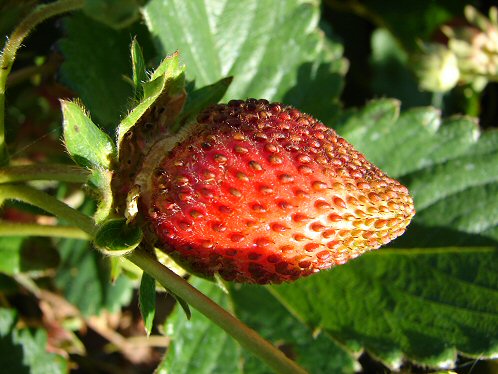 |
| Strawberry or Strawberries, Fragaria x ananassa "EarliGlow." | Strawberry or Strawberries, Fragaria x ananassa "EarliGlow." |
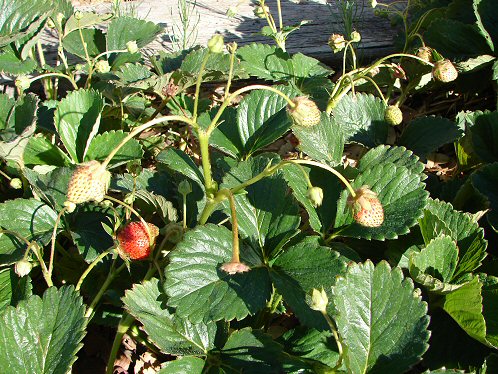 | 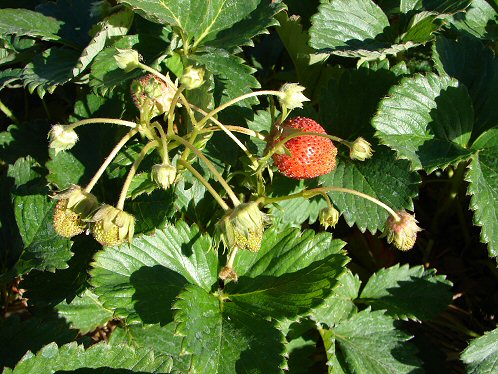 |
| Strawberry or Strawberries, Fragaria x ananassa "EarliGlow." | Strawberry or Strawberries, Fragaria x ananassa "EarliGlow." |
Strawberry or Strawberries.
HISTORY OF STRAWBERRIES: We can only trace the history of strawberries back over about 2,200 years. Strawberries grew wild in Italy as long ago as 234 B.C. and were discovered in Virginia by the first Europeans when their ships landed there in 1588. The early settlers in Massachusetts enjoyed eating strawberries grown by local Native American Indians who cultivated strawberries as early as 1643. The first colonists in America shipped the native larger strawberry plants back to Europe as early as 1600. Another variety was also discovered in Central and South America, which the conquistadors called futilla. Early Americans did not bother cultivating strawberries, because they were abundant in the wilds. After 1860 strawberries were widely grown in many other parts of the United States. It is said that Native American Indians invented Strawberry shortcake, by mashing strawberries in meal to make bread the colonists enjoyed -- but they must have used wild strawberries, since strawberries have only been cultivated in America since about 1835. The Hoveg variety was imported into Massachusetts from France in 1834. The Fraser clan in Scotland derived its name from the French immigrants named Strawberry (Fraise) who came with William the Conqueror in 1066. There are even references to the strawberry as far back as ancient Rome. There are many explanations for how strawberries got their name; some believe that the name came from the practice of placing straw around the growing plants for protection, others believe the name originated over 1000 years ago because of the runners which spread outward from the plant. The name may have been derived from the Anglo-Saxon verb to strew (spread) and the fruit came to be known as streabergen, straberry, streberie, straibery, straubery, and finally, "STRAWBERRY� to the English. Although they have been around for thousands of years, strawberries were not actively cultivated until the Renaissance period in Europe. We do know that strawberries were served at medieval state events, they symbolized prosperity, peace, and perfection. It is known that Russian empresses also loved them. Today, one of the most famous public eating of strawberries is at Wimbledon each year, when strawberries and cream are consumed between tennis matches by, of course, properly attired English. Cultivation in the United States began in earnest in the early part of the 19th century, when strawberries with cream quickly became considered a luxurious dessert. New York became a strawberry hub with the advent of the railroad, shipping the crop in refrigerated railroad cars. Production spread to Arkansas, Louisiana, Florida and Tennessee. Strawberries have been grown in California since the early 1900�s. Today, over 25,000 acres of strawberries are planted each year in California and the state produces over 80% of the strawberries grown in the United States. Many communities in California have Strawberry Festivals, with the first one dating back to 1850. On an average, each acre produces about 21 tons of strawberries and the state produces one billion pounds of strawberries a year! Cultivars of Fragaria � ananassa have replaced, in commercial production, the woodland strawberry, which was the first strawberry species cultivated in the early 17th century. DESCRIPTION OF STRAWBERRIES: The strawberry is a member of the rose family, Rosaceae, and are of the Fragaria genus. They are not berries or fruit at all, but enlarged ends of the plant's stamen. These are called: aggregate accessory fruits. Thus, the strawberry is, in technical terms, an aggregate accessory fruit, meaning that the fleshy part is derived not from the plant's ovaries but from the "receptacle" that holds the ovaries. Each apparent "seed", called an (achene) on the outside of the fruit, is actually one of the ovaries of the flower, with a seed inside it. In both culinary and botanical terms, the entire structure is called a "fruit". Strawberry seeds are therefore on the outer skin, instead of in the inner berry, There are about 200 seeds per berry. The fruit is widely appreciated for its aroma, bright red color, juicy texture, and sweetness. It is consumed in large quantities, either fresh or in prepared foods such as preserves, fruit juice, pies, ice creams, and milk shakes. Artificial strawberry aroma is also widely used in all sorts of industrialized food products, such as home deoderants. The most common varieties are hybrids of the wild Virginia strawberry (native to North America) and a Chilean variety. The plant produces succulent, red, conical fruit from tiny white flowers, and sends out runners to propagate. There are more than 20 described species and many hybrids and cultivars. The most common strawberries grown commercially are cultivars of the garden strawberry, a hybrid known as Fragaria � ananassa. Strawberries have a taste that varies by cultivar, and ranges from quite sweet to rather tart. The key to the classification of the different strawberry species is recognizing that they vary in the number of chromosomes. Strawberries are an important commercial fruit crop, widely grown in all temperate regions of the world. Strawberry plants can produce for 5 to 6 years with careful cultivation, however most farmers use them as an annual crop, replanting yearly. Crops take 8 to 14 months to mature. Strawberries are considered social plants, requiring both a male and female to produce fruit. Strawberries are considered non-fat, and low in calories, rich in vitamin C, potassium, folic acid, fiber, and vitamin B6. Over history the strawberries have been used in medicines. They have been used for sunburn, discolored teeth, digestion, and gout. As far back as the 13th century, the Strawberry was used as an anaphrodisiac.
Here are some links to the Nature Hills Nursery; where you can order some of their very high quality Strawberry Vines. If you click, there is no obligation to buy! You will leave delange.org. NOTE: These are High Quality Speciality Vines. They are not usually found at the typical Big Box Stores!
GROWING STRAWBERRIES IN ARIZONA: Growing strawberries in Arizona can be frustrating, but they will grow here and we even had one relative who lived in Chino, Arizona and another in Phoenix, who each made a good income growing & selling strawberries. Here are the reasons it can be frustrating. Just about the time they take off and start pumping out berries, it gets too hot for them. Furthermore, they don't like our alkaline soil in Arizona, so most people have to practically replace the native soil with compost and other amendments to get them to grow. With that being said, if you want to grow strawberries, we suggest upon trying the best variety for growing here which appears to be Sequoia, Camarosa, & Chandler. A garden that receives full sun is best. When to Plant: Plant strawberries as soon as the ground can be worked in the spring. This is usually in March or April allowing the plants to become well established before the hot weather arrives. Do not work the soil if it is wet. Wait a few days until it dries. Planting Depth: Try to plant strawberries on a cloudy day or during the late afternoon. Set the strawberry plant in the soil so that the soil is just covering the tops of the roots. Do not cover the crown. After four or five weeks, the plants will produce runners and new daughter plants. Planting Systems:
Matted Row Systems:
Spaced-Row Systems:
Hill System:
During the first growing season, remove the flowers of June-bearing strawberries as soon as they appear. Removing the flowers promotes root and runner development thereby insuring a large crop the following year. For everbearing and day-neutral strawberries, remove the flowers until the end of June and then after that date allow the flowers to remain to set fruit for your summer/fall harvest. Strawberries prefer a well drained soil, high in organic matter. They need full sun for the highest yields, at least 6 hours per day. Do not plant strawberries where peppers, tomatoes, eggplant and potatoes have been grown. These plants could harbor verticillium wilt, a serious strawberry disease. Strawberries need about one inch of water per week during the growing season. Before planting apply one pound per 100 square feet of a 10-10-10 fertilizer and dig into soil at least six to eight inches deep. Arizona can have very cold weather in the higher elevations and strawberries are very susceptible to frosts in the spring. Mulches that have covered the plants during the winter months should be removed in the early spring but should be left in the aisles to cover the blossoms in the spring when frost is predicted. Old blankets or sheets can be used for protection against frost. Spun bond material such as Reemay or row covers will protect strawberry plantings down to temperatures of about 23�-25�F. In the fall between mid-November and mid-December in cold regions, but before temperatures drop below 20 degrees; apply a straw mulch three to four inches deep over the rows. This mulch will protect the plants from cold temperatures that can kill the buds and injure roots and crowns. Remove the mulch in the spring when the strawberry leaves show yellow. Leave some of the mulch around the plants to keep the fruit from soil contact and to conserve soil moisture. Renovation is an important part of strawberry care. In order to insure good fruit production, June-bearing strawberries grown in the matted row system should be renovated every year right after harvest. A strawberry patch will continue to be productive for three to four years as long as the planting is maintained. The first step in the renovation process is to mow the old foliage with a mower, cutting off the leaves about one inch above the crowns. Rake the leaves and if disease-free, compost or incorporate into the soil. Fertilize with one pound of a 10-10-10 fertilizer per 100 square feet. Narrow the rows to six to twelve inches wide by spading, hoeing or rototilling. Remove all weeds. Thin the plants in the narrowed row to 4 to 6 inches between plants. Water with one inch of water per week to promote growth and to make new runners for next year's crop. After the first harvest in the second season strawberries should be fertilized after renovation in July. Water the fertilizer in to get it down to the root zone. This application is made to keep the plants in a vigorous condition and to promote new growth causing the development of more fruit buds. Do not over fertilize. Overfertilization will cause excessive vegetative growth, reduce yields; increase losses from frost and foliar disease and result in winter injury. We strongly suggest using raised beds. If using raised beds the same proceedures can be followed. HINTS & TIPS: If weather conditions are favorable, each strawberry plant should produce a yield of one quart of berries. How to Choose Strawberry Plants: The three basic types of strawberry plants are Day Neutral, Ever Bearing and June Bearing. However this designation is under revision. "June-bearing" strawberries, bear their fruit in the early summer and "ever-bearing" strawberries, which often bear several crops of fruit throughout the season.
Day Neutral:
Ever Bearing:
June Bearing:
New research has shown that strawberries actually occur in three basic flowering habits: short-day, long-day, and day-neutral. These refer to the day-length sensitivity of the plant and the type of photoperiod that induces flower formation. Day-neutral cultivars produce flowers regardless of the photoperiod. Always plant strawberries in an area where they will get at least eight hours of sunlight a day. Never plant strawberries where eggplant, peppers, potatoes or tomatoes were grown the previous year. This will cause Verticillium Rot. Always plant strawberries early in the spring as soon as the soil is dry enough to cultivate and the chance of frost is past. When purchasing check to be certain that plants are certified disease free. Always chose plants that have light colored roots, large crowns and green leaves free of blight or brown patches. Add one to two inches of compost or cow or sheep manure to the soil before planting. Keep your berry patch free of weeds. When planting dig the hole deep and wide enough that roots can be spread. Be sure the crown is level with the soil and that the soil comes only halfway up the crown. There should be at least four feet between strawberry rows. Plants should be set at least sixteen inches apart. Flowers will appear on the plants shortly after being set in the ground. These should be pinched off the first year to allow plants to mature on June Bearers. Pinch off all flowers that appear before July 1st on Day Neutral and Ever Bearing species. This also gives a boost to the production of runners. Though June Bearers will produce no fruit the first year, the removal of flowers will bring a larger harvest the following year and extend the life of your plants for several years. Mulch cools the soil temperature and stops weeds dead. Add mulch to areas between your plants as soon as they are planted. Mulch also keeps berries off the soil and prevents rotting. Straw is an excellent mulch to use for strawberry plants. Never use plastic to cover strawberry plants. It heats the soil and prevents the development of fruit. If you live in a cold climate, strawberry plants should be covered with straw before the first frost in the fall. This will prevent the crowns of the plants from being damaged. The straw should be removed early in the spring as soon as there is no chance of frost overnight. If you want your strawberry plants to yield lots of large, juicy berries, they will need two inches of water each week. Extra water should be given from the flowering to the fruit bearing stage. Strawberry plants should be planted in fertile soil and a balanced fertilizer applied. Most strawberry producers use 10-10-10, which is perfect. Spread one pound of fertilizer per 100 square feet for best results. Fertilize June Bearers after the harvest and Ever Bearers and Day Neutrals after the second harvest. Over fertilizing will result in lush leaf growth but few flowers. If you live in cold regions, never fertilize strawberry plants in the fall. This will result in new leaf growth that will be killed over the harsh winter. Strawberries are best to eat when fully ripe. Once they turn completely red, leave them on the vine for two days. The only way to determine if strawberries are ready to harvest is by tasting them. Once picked, set strawberries in the shade and when you are finished picking take them into the house. Water regularly; do not overwater. This plant is attractive to bees, butterflies and/or birds. Because the cultivated strawberry is a hybrid of two highly variable octoploid species, it is possible to raise strawberries profitably under extremely different conditions just about anywhere in the world.
DISEASES & PESTS:
The crown and roots may fall victim to red stele, verticillium wilt, black root rot, and nematodes. The fruits are subject to damage from gray mold, rhizopus rot, and leather rot. The plants can also develop disease from temperature extremes during winter. Be sure to water only the roots and not the leaves, as moisture on the leaves encourages growth of fungus. Strawberries that are placed in a windy area will prevent the fungus from occurring. About 200 species of pests are known to attack strawberries both directly and indirectly. These pests include slugs, moths, fruit flies, chafers, strawberry root weevils, strawberry thrips, strawberry sap beetles, strawberry crown moth, mites, aphids, and others. A number of species of Lepidoptera feed on strawberry plants.
NUTRITION:
Type: Aggregate Accessory Fruit.
|


We Are Proud Of Our SafeSurf Rating!
Here Are Some Links To The Very Best & Most Popular Items Sold On Amazon.Com
To Learn More! Click The Links Below. No Obligation, Of Course!
|
|
|---|
| Back To Arizona Vegetable & Fruit Gardening
|
| Back To Arizona Xeriscape Landscaping Main Page
|
| To Arizona Wild Flowers Home Page
|
| Back To DeLange Home Page
Images And Text Copyright Eve & George DeLange.
|


